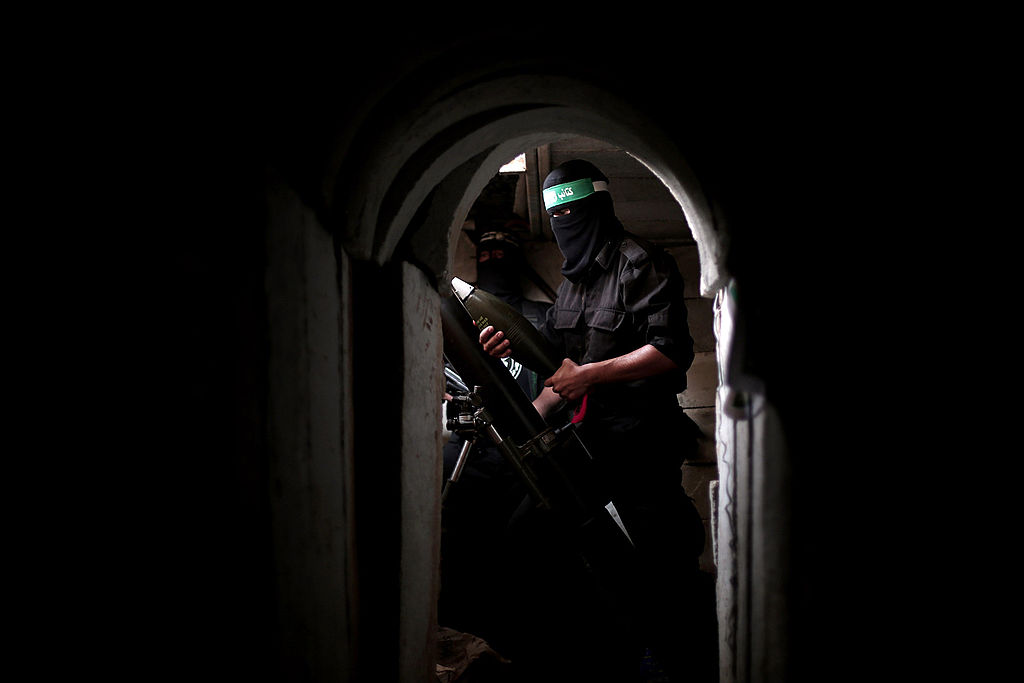
Israel’s intention in ordering the evacuation of civilians from Gaza City is to create a free-fire zone where anyone who remains can be assumed to be a member of Hamas. The next phase of its coordinated air, ground and naval offensive in Gaza will be putting in ground troops to secure northern Gaza, which will allow specialist units to start searching and destroying the Hamas tunnel system.
This phase could be costly in terms of Israeli lives because Hamas fighters underground will have access to the surface to inflict casualties on Israeli troops—in much the same way as Islamic State fighters did in Mosul when they inflicted heavy casualties on advancing Iraqi soldiers.
Gaza tunnel entrances are hidden under houses, mosques and schools, while the territory’s narrow streets and alleyways are expected to be infested with booby traps and command-detonated improvised explosive devices. It will also be difficult and dangerous for the Israel Defense Forces to clear a path through collapsed buildings and areas blocked by rubble.
Use of tunnelling is not a new insurgent tactic. Australia had experience of it in South Vietnam where A Company, of the 1st Battalion, Royal Australian Regiment, was ambushed from and uncovered the famous Cu Chi tunnel system. Insurgent forces that lack the capability to take on regular forces head to head can use tunnels to fight a survivable war of attrition that may eventually lead to war weariness and a negotiated settlement.
Once Israeli Special Forces get into the tunnel system, their aim will be to kill Hamas leaders, destroy Hamas fighters and weapons—particularly the rocket arsenal—and free any Israeli hostages held in the tunnels. However, it will be a costly process because Hamas is intimately familiar with the environment and has had time to booby-trap the tunnels and prepare defensive positions underground.
Indeed, Hamas has spent two decades building the labyrinth of deep, defensive tunnels to resist any ground assault by Israeli troops. It started building them in Gaza even before Israel withdrew its troops from Gaza in 2005. Hamas ramped up the construction after both Israel and Egypt imposed a blockade on the area in 2007.
The extensive tunnel network is believed to be as much as 30 metres beneath the surface in some places and is an integral part of the Gaza defences Hamas has spent years preparing.
After the last flare-up of fighting between Israel and Hamas in 2021, the IDF claimed to have destroyed more than 60 miles of tunnels. Hamas responded, saying that only 5% was damaged and that its underground infrastructure comprised 300 miles of tunnelling.
Daphne Richemond-Barak at Reichman University in Israel, an expert on the tunnel system, said the tunnels beneath Gaza were deeper and more sophisticated than the cross-border tunnels used to access Israeli territory.
She noted: ‘The tunnels inside Gaza are different because Hamas is using them on a regular basis. They are probably more comfortable to be in for longer periods of time. They are definitely equipped for a longer, sustained presence. The leaders are hiding there, they have command-and-control centres, they use them for transport and lines of communication. They are equipped with electricity, lighting and rail tracks.’
Jonathan Conricus, an IDF spokesperson, said in a briefing last week: ‘Think of the Gaza Strip as one layer for civilians and then another layer for Hamas. We are trying to get to that second layer that Hamas has built. These aren’t bunkers for Gazan civilians. It’s only for Hamas and other terrorists so that they can continue to fire rockets at Israel, to plan operations, to launch terrorists into Israel.’
Even if the Israeli forces are able to destroy the tunnels and clear Hamas out of northern Gaza, they will then have to decide whether to occupy the territory—which could take large numbers of troops—or to withdraw.
Tom Beckett, executive director of the International Institute for Strategic Studies in the Middle East, said: ‘If the IDF attempts to mount a garrison large enough to control Gaza while continuing to protect the country from threats emanating from the West Bank, southern Lebanon and Syria, its capacity will soon be stretched thinly.’
Israel had clearly become complacent under Prime Minister Benjamin Netanyahu about its ability to contain the Hamas threat and control Israel’s Palestinian population. The latest round of violence shows once again that Israel will at some point have to engage in a negotiated settlement with the Palestinian leadership, whoever that may turn out to be.
Even if Israel decides to force more than a million Palestinian civilians out of northern Gaza on a permanent basis, it still has to contend with the more than three million disaffected Palestinians living in the occupied West Bank and Jerusalem.

